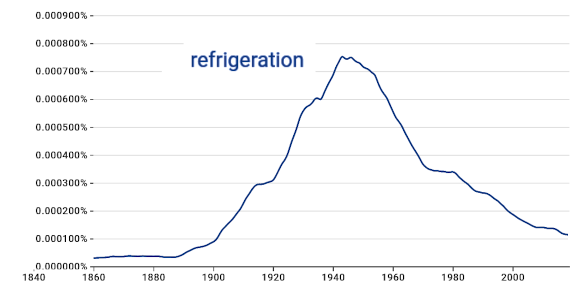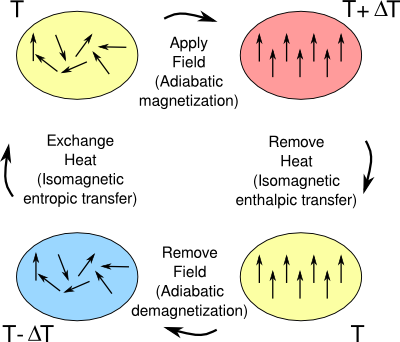
Ionocaloric Refrigeration
February 27, 2023 The baseline standard of living has vastly increased from the mid-20th century to the present day. In the 1955-1956 television sitcom, the honeymooners, the principal characters, Ralph Kramden (played by Jackie Gleason, 1916-1987) and his wife Alice (played by Audrey Meadows, 1922-1996) lived in a spare two room apartment with no telephone and an ice box for refrigeration. Today, people would think themselves to be abused if they didn't own a smartphone, have a widescreen television, and an electric refrigerator/freezer well stocked with junk food. Our present cozy lifestyle is a direct consequence of the labors of the many scientists and engineers who have created our technological society. The technological advances in refrigeration are a good example of our progress, and there's a website that lists a timeline of events in refrigeration history.[1] Some of these are as follow:• 1834 - Jacob Perkins (1766-1849), who is known as the father of the refrigerator, is granted the first patent for a vapor-compression refrigeration system.
• 1906 - Willis Carrier (1876-1950) patents the modern air conditioner.
• 1923 - Kelvinator attains 80% of the electric refrigerator market.
• 1926 - General Electric markets the first hermetic compressor refrigerator.
• 1926 - Albert Einstein (1879-1955) and Leo Szilard (1898-1964) invent a refrigerator having no moving parts.[2]
• 1955 - 80% of American households have a refrigerator.
• 2005 - 99.5% of American households have a refrigerator.

A graph of the frequency of occurrence by year of the word "refrigeration" via the Google Ngram Viewer (https://books.google.com/ngrams). The curve, not unexpectedly, resembles the graph known as the technology adoption life cycle. (Click for larger image.)
Albert Einstein, who was familiar with the patent process from his time as a patent examiner at the Swiss Patent Office, teamed with Leo Szilard on the design of a refrigerator. Their motivation was the report that an entire family had been killed as they slept by leaking refrigerator fumes.[2] The "Einstein refrigerator" still used the toxic refrigerants known at that time, but it was safer since it had no moving parts and did not require rotary seals (see figure).[3].

Figure from US Patent No. 1,781,541, "Refrigeration," by Albert Einstein and Leo Szilard, dated November 11, 1930.
The "Einstein refrigerator" is an absorption refrigerator in which the cooling evaporate is absorbed by another liquid, which is run through a heat exchanger to recover the refrigerant for another refrigeration cycle.
(Via Google Patents.)[3]
The common refrigeration method, as used in domestic and commercial refrigerators and air conditioners, is the vapor-compression cycle that utilizes the liquid to gas phase transition of a refrigerant, such as R-600a (isobutane, HC(CH3)3). The refrigerant vapor is compressed, and the higher pressure results in a higher temperature. This hot, compressed vapor is then condensed into a liquid by a heat exchanger where it is cooled. The condensed liquid refrigerant flows through an expansion valve where the abrupt reduction in pressure causes it to cool in a Joule expansion. It then flows through heat exchanger coils within the refrigerator to cool its interior. The interior warms the refrigerant to change it into a gas to feed again through the compressor, restarting the cycle. Aside from the vapor-compression cycle, there are several other methods of cooling. One of these is thermoelectric cooling in which a thermoelectric Seebeck effect device is used in inverse to cool one surface while heating another, rather than generating electricity from a hot-cold temperature difference. While this has the advantage of having no moving parts, it's far less efficient. I wrote about the thermoelectric effect in an earlier article (Thermopower on the Cheap, December 21, 2012). Far more interesting is the magnetocaloric effect, the subject of another of my articles (Magnetic Refrigeration, September 3, 2014). In 1881, German physicist Emil Warburg (1846-1931) found that iron, a magnetic material, would cool about a degree Celsius when subjected to an applied magnetic field of one tesla, the equivalent of 10,000 gauss.[4] The Earth's magnetic field is about half a gauss; so the effect is very small. This effect can be used in a magnetic refrigeration cycle (see figure).

The thermodynamic cycle of a magnetic refrigerator.
Refrigeration is achieved by using the entropy associated with the alignment of the magnetic moments of the atoms in a solid as a heat pump.
(Click for larger image.)
The magnetocaloric effect is greatest near the vicinity of a magnetic phase transition, and some alloys of gadolinium, such as Gd5Si2Ge2, exhibit a "giant magnetocaloric effect" (GMCE) around room temperature.[5] I wrote about this effect in a previous article (Giant Magnetocaloric Effect, September 10, 2018). Some of my former colleagues worked on magnetocaloric materials in the 1990s.[6] A recent article in Science describes a new refrigeration principle, ionocaloric refrigeration, which uses ions to drive solid-to-liquid phase transitions in a thermal cycle.[7-10] This technology was developed by Drew Lilley and Ravi Prasher, both at Lawrence Berkeley National Laboratory (Berkeley, California) and the University of California (Berkeley, California).[7] Unfortunately, even today's newer hydrofluorocarbon refrigerants have a global warming potential, and this problem is exacerbated by increased use of air conditioning in our warming world.[7-8,10] Hydrofluorocarbons are greenhouse gases that are thousands of times as powerful as carbon dioxide.[9] A 2022 climate agreement called the Kigali Amendment commits signatory nations to reduced production and consumption of hydrofluorocarbons by at least 80% over the next 25 years.[10] This has encouraged research on on alternatives to vapor-compression refrigeration, and ionocaloric cooling is one such technology.[9] Magnetocaloric refrigeration requires large applied fields, and they have low efficiency and offer just a small temperature change.[7,10] Ionocaloric cooling works by using ions to drive solid-to-liquid phase changes; and, having a liquid as part of the cycle makes it easier to exchange heat in the system.[9] The researchers have calculated that ionocaloric cooling has the potential to work at least as efficiently as vapor-compression systems.[9] The published ionocaloric cooling system uses an environmentally friendly salt and solvent.[10] The operating principle of ionocaloric cooling is the same freezing point depression principle by which added salt will cause water to freeze at lower temperature. A saturated solution of salt water has a freezing point of -21°C; but, to make this large temperature change useful in refrigeration, the process needs to be reversible.[7-8] The ionocaloric cycle used the flow of sodium iodide (NaI) ions from ethylene carbonate ((CH2O)2CO) as the reversible part of the cycle.[9-10] The sodium iodide is removed from the ethylene carbonate by electrodialysis, causing the ethylene carbonate to recrystallize and expel heat.[10]

Animation of the ionocaloric cooling process. Electric current flow causes ions to induce a solid to liquid phase transition in a material, and the material absorbs heat from the surroundings. Reversed current flow removes the ions, causing the material to recrystallize into a solid and release heat. (Lawrence Berkeley National Laboratory image by Jenny Nuss.)
Experiments have shown a larger adiabatic temperature change and entropy change per unit mass and volume for the ionocaloric system as compared with other caloric effects at equivalent low applied field strengths.[7] There's a 30% Carnot cycle efficiency and a temperature change as high as 25°C at about 0.22 volts.[7] Says study author, Drew Lilley,
"There's potential to have refrigerants that are not just GWP [global warming potential]-zero, but GWP-negative... Using a material like ethylene carbonate could actually be carbon-negative, because you produce it by using carbon dioxide as an input. This could give us a place to use CO2 from Carbon capture."[9]The ionocaloric cycle can be used for heating as well as cooling.[9] What's needed before commercialization are experiments on different combinations of materials and development of the components for an actual refrigeration unit.[9] Lilley and Prasher have filed a provisional patent application for the ionocaloric refrigeration cycle.[9] Research funding was provided by the United States Department of Energy in its Energy Efficiency and Renewable Energy Building Technologies Program.[7,9]
References:
- Timeline of Refrigerators and Low-Temperature Technology, History of Refrigeration Website.
- Gene Dannen, The Einstein-Szilard Refrigerators, Scientific American, January 1997, pp. 90-95.
- Albert Einstein and Leo Szilard, "Refrigeration," US patent No. 1,781,541, November 11, 1930 (via Google Patents).
- Anders Smith, "Who discovered the magnetocaloric effect?" The European Physical Journal H, vol. 38, no 4 (September,2013), pp 507-517.
- V. K. Pecharsky and K. A. Gschneidner, Jr., "Giant Magnetocaloric Effect in Gd5(Si2Ge2)," Phys. Rev. Lett., vol. 78 (June 9, 1997), Document No. 4494, DOI: http://dx.doi.org/10.1103/PhysRevLett.78.4494.
- J. M. Elbicki, L. Y. Zhang, R. T. Obermeyer, and W. E. Wallace, "Magnetic studies of (Gd1−x M x )5Si4 alloys (M=La or Y)," J. Appl. Phys., vol. 69, no. 8 (April 15, 1991), pp. 5571ff.
- Drew Lilley and Ravi Prasher, "Ionocaloric refrigeration cycle," Science, vol. 378, no. 6626 (December 22, 2022), pp. 1344-1348, DOI: 10.1126/science.ade1696.
- Emmanuel Defay, "Cool it, with a pinch of salt," Science, vol. 378,no. 6626 (December 22, 2022), p. 1275, DOI: 10.1126/science.adf5114.
- Lauren Biron, "Berkeley Lab Scientists Develop a Cool New Method of Refrigeration," Lawrence Berkeley National Laboratory Press Release, January 3, 2023.
- Presenting "ionocaloric" refrigeration: A new approach to efficient and sustainable cooling, American Association for the Advancement of Science Press Release, December 22, 2022.